
Mamallapuram
Whenever someone mentioned Tamil Nadu’s temples, the first image that would crop up in my head was a picture of Mamallapuram’s temples that I had seen in some magazine. The image of the temples had looked unbelievably gorgeous at that time. So when we boarded Tamil Nadu Tourism’s Mamallapuram-bound bus at 11am from Chennai, I was very excited and had a lot of expectations. Thankfully, I wasn’t let-down.
Tamil Nadu Tourism’s Hop-on-hop-off bus service starts 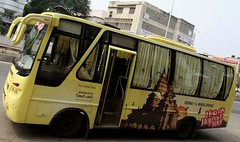 from Chennai and en route to Mamallapuram stops at a temple in Thiruvanmiyur, VGP Golden Beach Resort, Dakshinachitra, MGM Amusement Park and Muttukadu Boat House. Most travelers use this service as a convenient option to make day trips to these places. For us, it was a cost-effective option (Rs.200 per ticket) to get to Mamallapuram. The seats were comfortable and we were dropped off at the village center within 3hrs.
from Chennai and en route to Mamallapuram stops at a temple in Thiruvanmiyur, VGP Golden Beach Resort, Dakshinachitra, MGM Amusement Park and Muttukadu Boat House. Most travelers use this service as a convenient option to make day trips to these places. For us, it was a cost-effective option (Rs.200 per ticket) to get to Mamallapuram. The seats were comfortable and we were dropped off at the village center within 3hrs.
Situated along the coast, some 55kms south of Chennai, Mamallapuram was a port city for the great Pallava dynasty of the 7th century. It’s during their reign that the awesome UNESCO World Heritage recognized temples were built. The temples are spread over three distinct areas of the village and can be easily covered in a single day. Hence most travelers make this a day trip from Chennai. However, this also means that the place is absolutely crowded between 10am and 5pm, and one can’t really view the temples in peace; so we stayed back for a night!
After checking into a hotel and an afternoon siesta (more so to avoid the afternoon heat than rest!) we stepped out at around 4pm and headed straight to Mamallapuram’s Govt Museum, which lay towards the southern end of the village. Madhu and I love museums as they usually house some of the best pieces found in the region and showcase them beautifully. However, when we stepped into the courtyard of Mamallapuram’s museum, we were appalled to see many stone sculptures, painted in absurd colors of pink and blue displayed out in the sun. At first we thought that they had painted over priceless 7th century sculptures. Only on closer inspection did we realize that these were just poorly created copies that needed a coat of paint to cover the imperfections! Later we learnt that the ‘museum’ (it shouldn’t really be called that) is affiliated to the region’s sculpture school. The pieces displayed here were probably the work of students as none of them looked to be of professional quality. We were sorely disappointed; it was a terrible start to our day in Mamallapuram!
However things did get better. We continued walking south and came upon a wooded area to our right which was within a fenced enclosure. This enclosure contains a set of monuments, caves and temples, which have been built into a large, rocky hill that overlooks the village. The monuments have been preserved and maintained quite well and paved walkways (although not well-marked) connect them all making it easy to explore on foot. However, since it was a Sunday, the place was brimming with domestic visitors who were both noisy and prolific litterers; it wasn’t a very pleasant walk!
The monuments, though, were fabulous! There were mandapas with carved pillars, Rathas and cave temples with the most exquisite carvings ever! The mandapas were all carved into the rocky hill while the rest of the temples and caves were spread around it. Of all the mandapas, the carving in the Mahishasura-mardhini one was simply brilliant! The panel depicting the Goddess killing the demon, Mahishasur 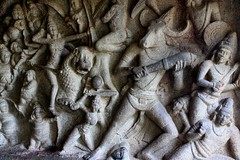 was about 7ft by 10ft in width and was beautifully detailed! Of the cave temples, the Varaha one had the nicest carving; though, my opinion could be biased as (for no apparent reason) I have a special affinity for Vishnu’s Varaha avatar. The panel was probably the same size and quality as the Mahishasuramardhini; loved them both! On walking further north, we came upon a monolithic temple structure dedicated to Lord Ganesha. This is called Ganesha Ratha because the temple architecture resembles the ‘Ratha’ or carriage that is used to carry out idols in procession during festivals in south India. The carvings on the facade of the temple were exquisite and it was hard to imagine that this was a monolithic structure!
was about 7ft by 10ft in width and was beautifully detailed! Of the cave temples, the Varaha one had the nicest carving; though, my opinion could be biased as (for no apparent reason) I have a special affinity for Vishnu’s Varaha avatar. The panel was probably the same size and quality as the Mahishasuramardhini; loved them both! On walking further north, we came upon a monolithic temple structure dedicated to Lord Ganesha. This is called Ganesha Ratha because the temple architecture resembles the ‘Ratha’ or carriage that is used to carry out idols in procession during festivals in south India. The carvings on the facade of the temple were exquisite and it was hard to imagine that this was a monolithic structure!
Just a few metres northwest of the Ganesha Ratha is a large boulder that looks like it’s going to tumble down the grassy hillock above which it dangles precariously at an angle. It’s curiously called Krishna’s Butterball presumably because the boulder looks similar to the balls of butter 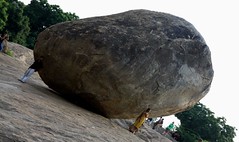 that are depicted in stories of Lord Krishna as a child. This looked like the most popular area as families lounged on the grassy hill and happily picnicked (and littered) in the shadow of the boulder. Children had the best time skidding down the slope on the butts only to land in a puddle of water (and litter!) at the base of the hill; it was fun to watch!
that are depicted in stories of Lord Krishna as a child. This looked like the most popular area as families lounged on the grassy hill and happily picnicked (and littered) in the shadow of the boulder. Children had the best time skidding down the slope on the butts only to land in a puddle of water (and litter!) at the base of the hill; it was fun to watch!
Beyond Krishna’s Butterball was a lovely cave temple dedicated to the Trinity of Hindu mythology – Lords Shiva, Vishnu and Brahma. It was appropriately called the Trimurthi caves with the image of each Lord in a separate cave enclosure. The central cave had a lovely, standing image of Lord Shiva with other deities praying to him. At his feet was a black-stone Lingam that looked polished and gorgeous!
However, the highlight of this section of monuments is the unbelievably grandiose panel called Arjuna’s Penance. The panel is right by the road and unfortunately not set back in a  grassy courtyard like the other monuments. Nevertheless it is a gorgeous piece of work unlike any we’d seen before. It’s called Arjuna’s Penance ‘coz the carving on the panel depicts a lean sage standing on one leg with his hands upraised doing penance. This sage is presumed to be Arjuna, one of the 5 Pandavas of Mahabharata. In the epic, before the big battle, he performs severe austerities to obtain Lord Shiva’s weapon. The panel, however, depicts another story as well where Bhagiratha performs a penance in order to bring the great Ganges river to earth. The central niche in the panel shows the course of the Ganges as it flows to the earth with the right-hand side of the panel depicting animals and celestial beings rushing to the water. In spite of its age (about 1400yrs old!) and exposure to the elements, the carvings on this panel still stand out exquisitely and are a treat to the eyes!
grassy courtyard like the other monuments. Nevertheless it is a gorgeous piece of work unlike any we’d seen before. It’s called Arjuna’s Penance ‘coz the carving on the panel depicts a lean sage standing on one leg with his hands upraised doing penance. This sage is presumed to be Arjuna, one of the 5 Pandavas of Mahabharata. In the epic, before the big battle, he performs severe austerities to obtain Lord Shiva’s weapon. The panel, however, depicts another story as well where Bhagiratha performs a penance in order to bring the great Ganges river to earth. The central niche in the panel shows the course of the Ganges as it flows to the earth with the right-hand side of the panel depicting animals and celestial beings rushing to the water. In spite of its age (about 1400yrs old!) and exposure to the elements, the carvings on this panel still stand out exquisitely and are a treat to the eyes!
We spent the rest of the evening browsing through the numerous stores in the village selling stone and metal sculptures. One store, Southern Arts and Crafts, near the bus station was quite nice. It stored both antiques as well as new idols that seemed to be of the highest quality. Some of the larger pieces were quite expensive but given the quality seemed well worth the money. The proprietor was a soft-spoken person who seemed to have a genuine passion for the arts. We were quite impressed! This store in Mamallapuram has been (mentally) added to the list of places I would like to go shopping for our future home someday!
The following morning we woke up early, had a quick breakfast and got to Mamallapuram’s star attraction, the Shore Temple by around 7:30am. There was practically no one around so we could walk 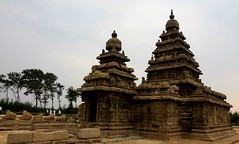 around the complex in leisure. Since this monument is protected under the UNESCO World Heritage list, it is enclosed within a large, grassy compound and is beautifully maintained. In the morning light, the temple looked unbelievably serene and gorgeous! Unlike the other monuments, the Shore temple is made of blocks of local granite and is not rock-cut! Its boundary wall is topped by a series of Nandi figurines, which is unique and my absolute favorite! The main shrine is dedicated to Lord Shiva. However a smaller shrine in the front is dedicated to a reclining Lord Vishnu. The sculptures on the facade of the temple are fabulous although a little eroded (compared to the inner ones) because of the sea. It is said that there are more such shrines on the shore of Mamallapuram but have been buried under the sea over the years. The recent tsunami that hit the region had washed up several idols and stone fragments to the shore, which supported the theory of the buried temples.
around the complex in leisure. Since this monument is protected under the UNESCO World Heritage list, it is enclosed within a large, grassy compound and is beautifully maintained. In the morning light, the temple looked unbelievably serene and gorgeous! Unlike the other monuments, the Shore temple is made of blocks of local granite and is not rock-cut! Its boundary wall is topped by a series of Nandi figurines, which is unique and my absolute favorite! The main shrine is dedicated to Lord Shiva. However a smaller shrine in the front is dedicated to a reclining Lord Vishnu. The sculptures on the facade of the temple are fabulous although a little eroded (compared to the inner ones) because of the sea. It is said that there are more such shrines on the shore of Mamallapuram but have been buried under the sea over the years. The recent tsunami that hit the region had washed up several idols and stone fragments to the shore, which supported the theory of the buried temples.
Later we took an auto to the Panch Rathas monument, which is at the southern-most end of the village. This one falls in the World Heritage list as well and is therefore quite nicely maintained 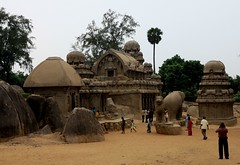 within a fenced enclosure. Called Panch Rathas because of the 5 monolithic temples that each resembles a processional chariot, this group of monuments is simply outstanding in execution. Each temple has been carved out of a single, pink blob of granite. Even though they have been named after the Pandavas & their wife (Arjuna, Bhima, Yudhistra, Nakula-Sahadeva and Draupadi), they are not related to the Mahabharata in any way. The Yudhistra Ratha is the largest with the tallest, pyramid-shaped Vimana, while the Draupadi Ratha is the smallest. However, it had the most exquisite carving of Ardhanarishwara on its outer facade. This along with a large, monolithic elephant and a Nandi were my favorites amongst the temple and animal monuments there. The pillared porches of the Arjuna and Bhima Rathas provided a shaded spot for us to sit and enjoy the lovely place. It had been a fabulous morning!
within a fenced enclosure. Called Panch Rathas because of the 5 monolithic temples that each resembles a processional chariot, this group of monuments is simply outstanding in execution. Each temple has been carved out of a single, pink blob of granite. Even though they have been named after the Pandavas & their wife (Arjuna, Bhima, Yudhistra, Nakula-Sahadeva and Draupadi), they are not related to the Mahabharata in any way. The Yudhistra Ratha is the largest with the tallest, pyramid-shaped Vimana, while the Draupadi Ratha is the smallest. However, it had the most exquisite carving of Ardhanarishwara on its outer facade. This along with a large, monolithic elephant and a Nandi were my favorites amongst the temple and animal monuments there. The pillared porches of the Arjuna and Bhima Rathas provided a shaded spot for us to sit and enjoy the lovely place. It had been a fabulous morning!
Even though the village of Mamallapuram felt crowded, commercialized and dirty, its monuments are of the highest quality and cannot be missed. We were glad we stayed a night as it gave us the chance to visit its top two monuments in the relative peace of an early, weekday morning!


No comments yet.